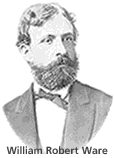William Robert Ware

William Robert Ware (27 May 1832 – 9 June 1915), born in Cambridge, Massachusetts into a family of the Unitarian clergy, was an American architect,[1] author, and founder of two important American architectural schools.
He received his own professional education at Milton Academy, Harvard College and Harvard's Lawrence Scientific School. In 1859, he began working for Richard Morris Hunt, the founder of the first American architectural school, the AIA, and the first American to graduate from the Ecole des Beaux-Arts. Soon afterward Ware formed a partnership with the civil engineer Edward S. Philbrick, Philbrick and Ware, and they designed the Swedenborgian High Street Church in Brookline, Massachusetts.
In 1864, Ware partnered with fellow Harvard graduate Henry Van Brunt to form Ware & Van Brunt. Their Boston-area designs include Harvard's Memorial and Weld Halls, the Episcopal Divinity School campus in Cambridge, Massachusetts, the Walter Hunnewell house (1875) at the Hunnewell estate in Wellesley (then West Needham), and the Ether Monument at the Boston Public Garden.[2] In 1865, Ware became the first professor of architecture at the Massachusetts Institute of Technology. Architect Joseph Lyman Silsbee apprenticed under Ware and Van Brunt after graduating MIT in 1869. [3]
In 1881 Ware and Van Brunt amicably dissolved their partnership, and Ware moved to New York City to found the School of Architecture at Columbia University, which began as the Architecture Department in the Columbia School of Mines.[4][5] He retired in 1903 in poor health.
Ware also dabbled briefly in voting systems and used the idea of the single transferable vote to devise what is now called, in the U.S., instant-runoff voting[6] (or, as it is better known outside the U.S., the alternative vote), around 1870, used in several English speaking countries.
Publications
References
- ↑ http://www.cpc.leg.state.pa.us/cpcweb/hist_ware.jsp
- ↑ http://web.mit.edu/museum/ware/ware_bio.html
- ↑ https://en.wikipedia.org/wiki/Joseph_Lyman_Silsbee
- ↑ Chewning, J. A. "William Robert Ware at MIT and Columbia."Journal of Architectural Education, v33 n2 p25-29 Nov 1979
- ↑ "William Robert Ware and the beginnings of architectural education in the United States, 1861-1881".
- ↑ "Archived copy". Archived from the original on 2009-10-28. Retrieved 2005-11-09.
External links
- The Ether Monument at dcMemorials.com